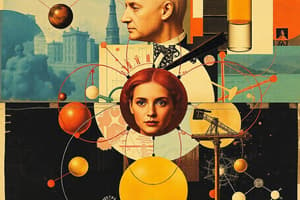Podcast
Questions and Answers
Who was the English scientist who came up with the atomic theory in 1803?
Who was the English scientist who came up with the atomic theory in 1803?
- Isaac Newton
- John Dalton (correct)
- Charles Darwin
- Albert Einstein
What is the meaning of the Greek word atomas from which 'atom' is derived?
What is the meaning of the Greek word atomas from which 'atom' is derived?
- Indivisible (correct)
- Infinite
- Fluid
- Massive
What did Dalton call the simplest units of compounds in his atomic theory?
What did Dalton call the simplest units of compounds in his atomic theory?
- Elements
- Molecules (correct)
- Particles
- Atoms
According to Dalton's atomic theory, what happens to atoms themselves when they combine in chemical reactions?
According to Dalton's atomic theory, what happens to atoms themselves when they combine in chemical reactions?
What did Dalton explain in his theory regarding the structure of compounds?
What did Dalton explain in his theory regarding the structure of compounds?
What was one of Dalton's major contributions to science?
What was one of Dalton's major contributions to science?
What did Michael Faraday's experiments in 1834 reveal about matter?
What did Michael Faraday's experiments in 1834 reveal about matter?
What prompted scientist Stoney to assume the existence of particles called electrons?
What prompted scientist Stoney to assume the existence of particles called electrons?
How was the electron discovered by scientist Thomson in 1897?
How was the electron discovered by scientist Thomson in 1897?
What did Thomson calculate from the magnitude of the electric field and the magnetic field?
What did Thomson calculate from the magnitude of the electric field and the magnetic field?
What happened when a magnetic field passed perpendicular to the electric field?
What happened when a magnetic field passed perpendicular to the electric field?
What effect did stopping the passage of electric current have on the electron beam?
What effect did stopping the passage of electric current have on the electron beam?
What did Thomson find when he applied an electric current through two plates until the electron beam returned to its original straight path?
What did Thomson find when he applied an electric current through two plates until the electron beam returned to its original straight path?
What did experiments at the end of the nineteenth century focus on?
What did experiments at the end of the nineteenth century focus on?
What does Michael Faraday's 1834 experiment show about chemical changes?
What does Michael Faraday's 1834 experiment show about chemical changes?
What did Michael Faraday's experiments show about atoms and molecules?
What did Michael Faraday's experiments show about atoms and molecules?
The atomic number of cobalt supported the existence of a new relationship between the arrangement of elements based on their atomic numbers and their properties.
The atomic number of cobalt supported the existence of a new relationship between the arrangement of elements based on their atomic numbers and their properties.
Goldstein observed a positive ray inside a cathode ray tube and proved that it was a positive particle with a charge equal to the charge of the electron.
Goldstein observed a positive ray inside a cathode ray tube and proved that it was a positive particle with a charge equal to the charge of the electron.
Chadwick confirmed the existence of neutrons by observing the emission of high-energy particles that carried a charge.
Chadwick confirmed the existence of neutrons by observing the emission of high-energy particles that carried a charge.
The number of neutrons in an atom can be calculated by subtracting the mass number from the atomic number.
The number of neutrons in an atom can be calculated by subtracting the mass number from the atomic number.
All atoms of an element have the same number of protons and neutrons.
All atoms of an element have the same number of protons and neutrons.
Moseley discovered X-rays in 1895.
Moseley discovered X-rays in 1895.
Moseley noticed that the collision of cathode rays in the X-ray tube of different elements gave the same energies.
Moseley noticed that the collision of cathode rays in the X-ray tube of different elements gave the same energies.
Moseley concluded that the number of positive charges in the nucleus decreases from one atom to another by individual electronic units.
Moseley concluded that the number of positive charges in the nucleus decreases from one atom to another by individual electronic units.
The atomic number of nickel is lower than the atomic number of cobalt.
The atomic number of nickel is lower than the atomic number of cobalt.
Moseley calculated the nucleus charge for the calcium atom to be +22.
Moseley calculated the nucleus charge for the calcium atom to be +22.




